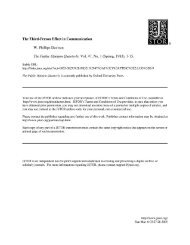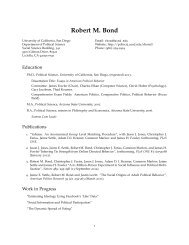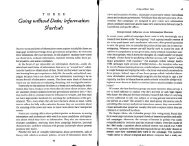Chapter 6 Why Authoritarian Parties? The Regime Party as an ...
Chapter 6 Why Authoritarian Parties? The Regime Party as an ...
Chapter 6 Why Authoritarian Parties? The Regime Party as an ...
You also want an ePaper? Increase the reach of your titles
YUMPU automatically turns print PDFs into web optimized ePapers that Google loves.
CHAPTER 6<br />
party service <strong>an</strong>d benefits hierarchically is therefore to provide incentives for juniors at<br />
a m<strong>an</strong>ageable cost to the regime. When the dem<strong>an</strong>ds on service <strong>an</strong>d the entitlement to<br />
benefits vary across the r<strong>an</strong>ks of the party, the provision of too large benefits may strain<br />
the regime’s resources where<strong>as</strong> the dem<strong>an</strong>d of too much service may discourage prospective<br />
members.<br />
In order to better underst<strong>an</strong>d the implications of hierarchical <strong>as</strong>signment of service <strong>an</strong>d<br />
benefits for incentive5s to join the party, we may extend the above rudimentary model <strong>as</strong><br />
follows. Suppose that each citizen now lives indefinitely over time periods t = 1,2,... In<br />
<strong>an</strong>y period, a citizen who is not a party member earns a wage w. As above, if a citizen<br />
joins the regime party, she starts at the junior r<strong>an</strong>k <strong>an</strong>d provides party service that entails<br />
a per-period cost c; once promoted to the senior r<strong>an</strong>k, she obtains the per-period benefit<br />
b > w > 0.<br />
A citizen’s payoff from a career within the party depends on the regime’s promotion <strong>an</strong>d<br />
retirement policies. In <strong>an</strong>y period, a junior member is promoted to a senior r<strong>an</strong>k with the<br />
probability p ∈ [0,1]. Me<strong>an</strong>while, a senior member is retired with the probability r ∈ [0,1]<br />
<strong>an</strong>d receives the wage w after retiring. 13 Thus senior party member i’s expected discounted<br />
career payoff is<br />
where u N i<br />
u S i = b+δ[ruN i +(1−r)uS i<br />
], (6.1)<br />
= w/(1 − δ) is the discounted career payoff of non-members <strong>an</strong>d δ ∈ (0,1) is a<br />
13 Lazarev (2005; 2007) develops a related model of a single party with two levels of membership <strong>an</strong>d<br />
examines the optimal structure of promotion <strong>an</strong>d retirement rules. Among other things, the present model<br />
differs from Lazarev’s by explicitly comparing the resilience of dictatorships with <strong>an</strong>d without a regime party<br />
to potential challengers.<br />
17











